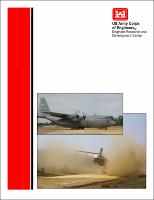Please use this identifier to cite or link to this item:
https://hdl.handle.net/11681/10516Full metadata record
| DC Field | Value | Language |
|---|---|---|
| dc.contributor.author | Anderton, Gary L. | - |
| dc.contributor.author | Gartrell, Chad A. | - |
| dc.date.accessioned | 2016-06-20T13:57:24Z | - |
| dc.date.available | 2016-06-20T13:57:24Z | - |
| dc.date.issued | 2005-01 | - |
| dc.identifier.uri | http://hdl.handle.net/11681/10516 | - |
| dc.description | Technical Report | - |
| dc.description | Abstract: The U.S. Army Engineer Research and Development Center (ERDC) began a 6-year comprehensive research, development, and demonstration program in 2002 entitled the Joint Rapid Airfield Construction (JRAC) program. The JRAC program is focused on providing engineering tools and systems that will dramatically increase the U.S. military’s contingency airfield upgrade and construction capabilities. One project within the JRAC program is entitled “Rapid MOG Enhancement Technologies.” The term MOG refers to the maximum-on-ground rating, or the number of aircraft that can remain on the ground at any one time at a given airfield. Rapid expansion of existing airfield parking areas or construction of new aircraft parking space is the focus of the Rapid MOG Enhancement Technologies project. This report describes the results of an experiment on pavement matting systems for use in contingency airfield operations. In particular, the matting systems were evaluated for their ability to carry military helicopter and C-130 cargo aircraft loads over semiprepared soil foundations. The scope of these evaluations included a contingency helipad field trial and a series of controlled test sections with C-130 traffic loads. Results of the contingency helipad field trial indicated that all four mat systems evaluated significantly reduced foreign object debris and “brownout” conditions from helicopters; however, the prescribed logistical requirements lead to the Mobi-Mat system as the best choice. The C-130 test section experiments indicated that two of the five mat systems evaluated should not be given further consideration, one mat showed promise but needs further manufacturing refinements, one mat carried the C-130 loads very well but is somewhat heavy, and the final mat carried C-130 loads well with limitations on soil strength and number of aircraft passes. | - |
| dc.publisher | Geotechnical and Structures Laboratory (U.S.) | - |
| dc.publisher | Engineer Research and Development Center (U.S.) | - |
| dc.relation | http://acwc.sdp.sirsi.net/client/en_US/search/asset/1003355 | - |
| dc.relation.ispartofseries | ERDC/GSL TR ; 05-2 rept.1. | - |
| dc.rights | Approved for public release; distribution is unlimited. | - |
| dc.source | This Digital Resource was created in Microsoft Word and Adobe Acrobat | - |
| dc.subject | Airfield matting | - |
| dc.subject | Apron matting | - |
| dc.subject | JRAC | - |
| dc.subject | Maximum-on-ground enhancement | - |
| dc.subject | Rapid soil stabilization | - |
| dc.subject | Taxiway matting | - |
| dc.subject | Landing mats | - |
| dc.title | Rapid Maximum-On-Ground (MOG) enhancement technologies. Report 1, Matting systems for contingency helipads and C-130 test sections | - |
| dc.type | Report | en_US |
| Appears in Collections: | Technical Report | |
